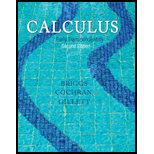
Concept explainers
Double integrals—transformation given To evaluate the following integrals, carry out the following steps.
a. Sketch the original region of
b. Find the limits of integration for the new integral with respect to u and v.
c. Compute the Jacobian.
d. Chance variables and evaluate the new integral.
74.
Want to see the full answer?
Check out a sample textbook solution
Chapter 13 Solutions
Calculus: Early Transcendentals, 2nd Edition
Additional Math Textbook Solutions
Introductory Statistics
Elementary Statistics: Picturing the World (7th Edition)
Calculus for Business, Economics, Life Sciences, and Social Sciences (14th Edition)
College Algebra with Modeling & Visualization (5th Edition)
College Algebra (7th Edition)
- Complete the table. Enter DNE if a quantity doesn't exist or NEI if not enough information is given. f(c) limx-->c- f(x) limx-->c+ f(x) limx -->c f(x) continuity at x=c 2 4arrow_forwardFind the indefinite integral. (Use C for the constant of integration.) 9x arcsin(x) dxarrow_forwardFind the indefinite integral using the substitution x = 5 sin(e). (Use C for the constant of integration.) 1 dx (25-x²)3/2arrow_forward
- Find the indefinite integral using the substitution x = 7 sec(0). (Use C for the constant of integration.) √ ׳ √x² - 49 dxarrow_forward2 Graph of h 6. The graph of the function h is given in the xy-plane. Which of the following statements is correct? , the graph of h is increasing at an increasing rate. (A) For (B) For (C) For 苏|4 K|4 π π , the graph of h is increasing at a decreasing rate. 2 0 and b>1 (B) a>0 and 01 (D) a<0 and 0arrow_forward3. Consider the sequences of functions fn: [-T, π] → R, sin(n²x) n(2) n (i) Find a function f : [-T, π] R such that fnf pointwise as n∞. Further, show that f uniformly on [-T,π] as n→ ∞. [20 Marks] (ii) Does the sequence of derivatives f(x) has a pointwise limit on [-7,π]? Justify your answer. [10 Marks]arrow_forwardGood Day, Please assist with the following. Regards,arrow_forwardFor each given function f(x) find f'(x) using the rules learned in section 9.5. 1. f(x)=x32 32x 2. f(x)=7x+13 3. f(x) = x4 4. f(x) = √√x³ 5. f(x) = 3x²+ 3 x2arrow_forwardFind: lim x →-6 f (x) limx-4 f (x) lim x-1 f (x) lim x →4 f (x) (-6,3) • (-1,5) -8 -7 (-6,-2) 4+ (4,5) (4,2) • (-1,1) -6arrow_forwardarrow_back_iosSEE MORE QUESTIONSarrow_forward_ios
 Functions and Change: A Modeling Approach to Coll...AlgebraISBN:9781337111348Author:Bruce Crauder, Benny Evans, Alan NoellPublisher:Cengage Learning
Functions and Change: A Modeling Approach to Coll...AlgebraISBN:9781337111348Author:Bruce Crauder, Benny Evans, Alan NoellPublisher:Cengage Learning College Algebra (MindTap Course List)AlgebraISBN:9781305652231Author:R. David Gustafson, Jeff HughesPublisher:Cengage Learning
College Algebra (MindTap Course List)AlgebraISBN:9781305652231Author:R. David Gustafson, Jeff HughesPublisher:Cengage Learning

